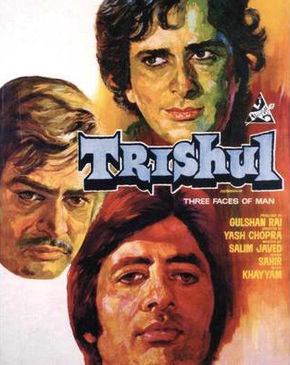Keep pushing yourself — The “Trishul” way
CAUTION: Too much bollywood filmy drama ahead. (T)Read carefully!
As entrepreneurs, we all need constant source of inspiration to keep pushing ourselves especially in tough times.
Many of the entrepreneurs come from modest backgrounds, especially in a developing country like India. For most of them, aspiration to become rich; the idea of making big; desire to do better than their parents keep them going during hard times. These desires keep the fire alive throughout their entrepreneurship journey.
But many of us (specifically millennials) come from the upper middle class or rich families. We always had the basic necessities to lead a comfortable life. Even if we don’t work too hard as entrepreneurs, we may never become poor in our lifetime.
In such cases, initially we may work hard to carve out our own name, to do something different but if we don’t achieve considerable success in, let’s say 10–15 years, we may become complacent. That drive of becoming wildly successful may go away.
Over the period, we may also acquire more wisdom and realise that this is all futile and ultimate goal is to achieve happiness and be happy in whatever you have, etc. But deep down we know that these are excuses to shy away from our failures as entrepreneurs. In a way, we are accepting defeat.
What to do in such cases? What should keep us driving when you reach this stage of life? How to keep that fire in the belly burning?
After all, we don’t want to be weak men creating hard times because we were born in good times.
Can we take inspiration from any external sources to keep us going?
May be from an entrepreneur we love;
May be from a book we read;
May be from a movie we watched.
However crazy it may sound, I get my daily dose of inspiration from the bollywood movie — “TRISHUL” starring Amitabh Bachchan, Sanjeev Kumarand Shashi Kapoor.

If you are not from India, you won’t know this movie but if you are an Indian and entrepreneur, you must watch this movie. You simply don’t have an option.
And for those who don’t know Amitabh Bachchan, he is like Al Pacino, Michael Douglas and Robert Di Niro combined in one actor (may be more)!
Here is Trishul’s partial movie plot, taken from Wikipedia:
Raj Kumar Gupta (Sanjeev Kumar) gives up his first love Shanti (Waheeda Rehman) to marry a wealthy heiress Kamini (Gita Siddharth), who is the daughter of Seth Dindayal. Shanti comes by to wish him success on his marriage with the news that she is carrying his child and moving away. She gives birth to a boy and names him Vijay. She raises him to adulthood. After she dies, Vijay (Amitabh Bachchan) comes to Delhi to take revenge by destroying his father’s business and family connections.
Vijay’s desire to avenge his mother is so strong, it can be highly motivating if channelised in the right direction. When I feel low as an entrepreneur, I try and remember some of the incidences from the movie to push myself.
Allow me to elaborate some of them.
1. Mere paas na baap dada ki daulat hai, aur naahi mujhe chahiye…
In above scene, Vijay makes a deal of half a million with Mr. R. K. Gupta (his first deal), when he didn’t even have 5 paisa (or cents) in his pockets.
When I need courage to take some seemingly impossible decisions, this scene invariably comes to my mind.
2. Nahin Geeta mere paas waqt bilkul nahin hein.. mein bahot jaldi mein hoon. Kyunki jo kaam logon ne 25 baras mein kiya hein, mujhe 1 baras mein karna hein…
In above scene, Vijay tells Geeta that he doesn’t have time to wait (for some deal to close). He wants to achieve all of that in 1-year, which his father Mr. R. K. Gupta achieved in 25-years.
When I become complacent or procrastinate, this scene helps me get back that “Sense of urgency” as an entrepreneur.
3. Tumhe lagta hai main rupiya kama raha hu.. nahi! main kisi se apni maa ke ansuyo ka hisab le raha hu.
In the above scene, Vijay loses a major deal against his father Mr. R. K. Gupta. His first ever loss. He is restless and angry. Geeta reminds him that he still has a lot of money; what is the big deal if he has lost just one deal. Vijay gets furious, shows her his mother’s photo and explains her his true motive behind all of this — to avenge his mother by destroying his father’s business and personal connections.
It is not just about the money. My work has a broader meaning! — I keep reminding myself with this.
Here are some other mind-blowing dialogues from the movie. They no longer make such movies.
Of course, this is fiction and most of us don’t have such a strong a desire to avenge our mothers (especially because of our respective fathers!), but I believe if we can put ourselves in some strong fictitious character, it can do wonders. It definitely helps me reignite the fire and bring me out of my comfort zone.
I guess I made my point. Now closing thoughts…
My father is a strong man because of hard times he faced in his life. He created good times for his family. I definitely don’t want to be the weak man creating hard times for my family!
Too much filmy? I know but I warned you in advance 🙂
So, how do you push yourself in hard times?
I am Abhishek Desai, co-founder of Digicorp.
Digicorp is a venture builder based in Ahmedabad, India. We build usable software products for startups. We also work on home–grown ideas and spin off the most promising ones as separate ventures.










